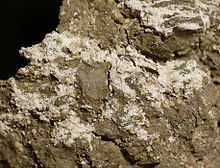| Brushite | |
|---|---|
 Brushite (white) on
montmorillonite | |
| General | |
| Category | Phosphate mineral |
|
Formula (repeating unit) | Ca H PO4 · 2 H2O |
| IMA symbol | Bsh [1] |
| Strunz classification | 8.CJ.50 |
| Crystal system | Monoclinic |
| Space group | Ia (no. 9) |
| Unit cell | a = 6.265 Å, b = 15.19 Å, c = 5.814 Å; β = 116.47°; Z = 4 |
| Identification | |
| Color | Colorless to pale or ivory-yellow |
| Crystal habit | Prismatic to tabular acicular crystals; typically powdery or earthy |
| Cleavage | Perfect on {010} and {001} |
| Tenacity | Brittle |
| Mohs scale hardness | 2.5 |
| Luster | Vitreous, pearly on cleavages |
| Diaphaneity | Transparent to translucent |
| Specific gravity | 2.328 |
| Optical properties | Biaxial (+) |
| Refractive index | nα = 1.539 – 1.540 nβ = 1.544 – 1.546 nγ = 1.551 – 1.552 |
| Birefringence | δ = 0.012 |
| 2V angle | Measured: 59 to 87° |
| Solubility | Readily in HCl |
| Other characteristics | Piezoelectric |
| References | [2] [3] [4] [5] [6] |
Brushite is a phosphate mineral with the chemical formula Ca HPO4·2 H2O. Crystals of the pure compound belong to the monoclinic space group C2/c and are colorless. [2] [5] It is the phosphate analogue of the arsenate pharmacolite.
Discovery and occurrence
Brushite was first described in 1865 for an occurrence on Aves Island, Nueva Esparta, Venezuela, and named for the American mineralogist George Jarvis Brush (1831–1912). [4] It is believed to be a precursor of apatite and is found in guano-rich caves, formed by the interaction of guano with calcite and clay at a low pH. It occurs in phosphorite deposits and forms encrustations on old bones. It may result from runoff of fields which have received heavy fertilizer applications. [4] Associated minerals include tanarakite, ardealite, hydroxylapatite, variscite and gypsum. [2]
Brushite is the original precipitating material in calcium phosphate kidney stones. [7] It is also one of the minerals present in dental calculi.
References
- ^ Warr, L.N. (2021). "IMA–CNMNC approved mineral symbols". Mineralogical Magazine. 85 (3): 291–320. Bibcode: 2021MinM...85..291W. doi: 10.1180/mgm.2021.43. S2CID 235729616.
- ^ a b c Anthony, John W.; Bideaux, Richard A.; Bladh, Kenneth W.; Nichols, Monte C., eds. (2000). "Brushite". Handbook of Mineralogy (PDF). Vol. IV (Arsenates, Phosphates, Vanadates). Chantilly, VA, US: Mineralogical Society of America. ISBN 0962209732. Archived from the original (PDF) on 2016-03-04.
- ^ Brushite. Mineralienatlas]
- ^ a b c Brushite. Mindat.org
- ^ a b Brishite. Webmineral
- ^ Schofield, P. F.; Knight, K. S.; Houwen, J. A. M. van der; Valsami-Jones, E. (December 2004). "The role of hydrogen bonding in the thermal expansion and dehydration of brushite, di-calcium phosphate dihydrate". Physics and Chemistry of Minerals. 31 (9): 606–624. Bibcode: 2004PCM....31..606S. doi: 10.1007/s00269-004-0419-6. S2CID 94011250.
- ^ "Brushite". Virtual Museum of Molecules and Minerals. Retrieved 22 December 2017.